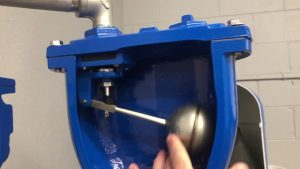A large number of thermoplastic materials are offered in valves, mainly as soft-seat options for ball valve applications. Also lined valves like a lined butterfly valve, lined globe valve, lined check valve.
Ball Valve Seat
Ball valves play a critical role in controlling the flow of fluid and pressure within a pipeline, but their effectiveness and safety are only as good as the seat material used. In this blog post, we are going to review the basics of five commonly used ball valve seat materials.
Ball Valves
Whether found in a petrochemical application where a leak could be environmentally devastating, or in a pharmaceutical laboratory where cleanliness and sanitation are critical, ball valve seats must be reliable and robust. A ball valve consists of the body of the valve, the body cap, the stem, the solid ball, and the round ball valve seat.
The ball valve seat is responsible for sealing the fluid inside and uniformly distributing the seating stress. In soft seat ball valve designs, either an elastomer or polymer is used as the seal and is inserted into a metallic seat ring. This approach, as opposed to hard seat ball valves, is popular because it provides good sealing action, is lighter weight and is more cost-effective.
Key Properties of Ball Valve Seat Materials
When choosing a polymer material for a ball valve seat, numerous factors are involved. Key material properties include …
- Sufficient ductility to provide a reliable seal
- Dimensional stability to ensure the ball valve seat retains its shape for reliable sealing and performance
- Very low friction to keep stem torque at a minimum
- Low coefficient of thermal expansion so that the ball valve seat retains its shape when the temperature changes occur
- Excellent wear resistance for a long service life
- Chemical compatibility with all media involved
- In some operating environments, it is also important that ball valve seat materials exhibit these properties:
- Low moisture absorption to prevent dimensional changes in the presence of water or high humidity
- Maintain performance with repeated sterilization that can include hot water, steam, and harsh cleaning chemicals
- Good performance in the presence of sudden decompression (i.e., pressure drops over 650 psi)
Recommended Materials for Ball Valve Seats
Several materials work well as ball valve seats, including acetal, PEEK, PTFE, TFM, and UHMW-PE.
PEEK Ball Valve Seats
Temperature Range: -50°F to 550°F
Max Pressure at Room Temperature: 6000 psi
Color: Beige
PEEK offers excellent chemical resistance, very low friction, self-lubrication, and is flame retardant while also possessing a wide operating temperature range (from -70°F to 550°F). It can handle very aggressive applications and works well when there is a need for hot water and steam exposure–but does not do well in the presence of sulfuric acid.
In addition, PEEK is very well adapted to nuclear applications and is available in FDA-approved grades as well as filled grades with improved wear properties and better thermal conductivity. Note that PEEK is usually chosen for ball valve seats when the operating temperature range is outside that of PTFE.
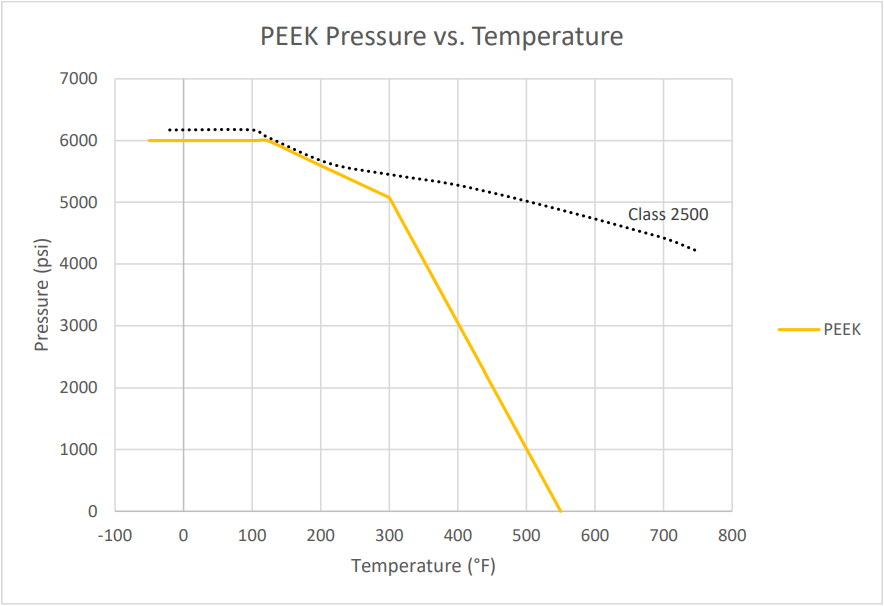
PTFE Ball Valve Seats
Temperature Range: -50°F to 400°F
Max Pressure at Room Temperature: 1000 psi
Color: White
PTFE (also known by its trade name, Teflon) has many of the same properties as PEEK but involves even lower friction, dry running capabilities, and more extensive chemical compatibility. Like PEEK, it is available in FDA-approved grades and can handle cryogenic temperatures down to -50°F and high temperatures up to 550°F as well as pressures up to 5,000 psi.
Also like PEEK, PTFE can continue to perform even when repeatedly exposed to hot water and steam. Keep in mind, however, that PTFE does not perform well in the presence of fluorine or alkalies. PTFE is also very easy to clean and available in glass or carbon-reinforced grades that can provide improved wear characteristics, less propensity to cold creep, and lower thermal conductivity.
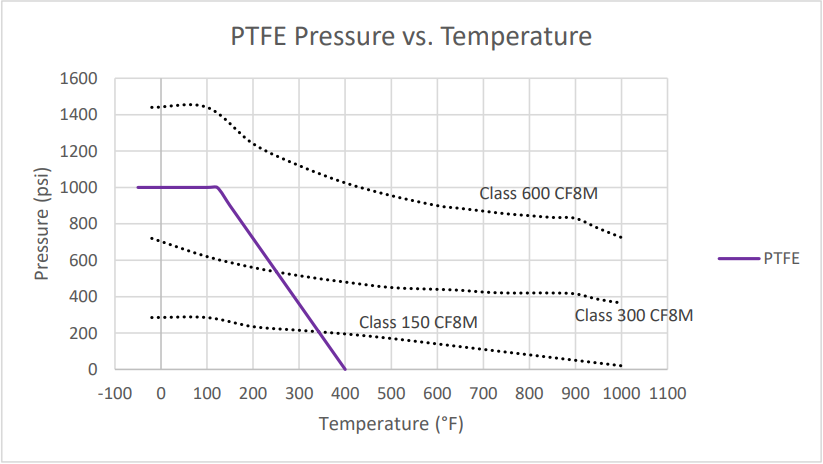
RPTFE Ball Valve Seats
Temperature Range: -50°F to 450°F
Max Pressure at Room Temperature: 2000 psi
Color: Off-White
RTFE has improved wear and abrasion resistance over PTFE while maintaining its chemical compatibility. Its versatile temperature characteristics allow RTFE to be used in saturated steam applications. RTFE is the standard seat material for most Zeco floating ball valves. This seat should not be used in caustic (sodium hydroxide, potassium hydroxide, etc.) service.
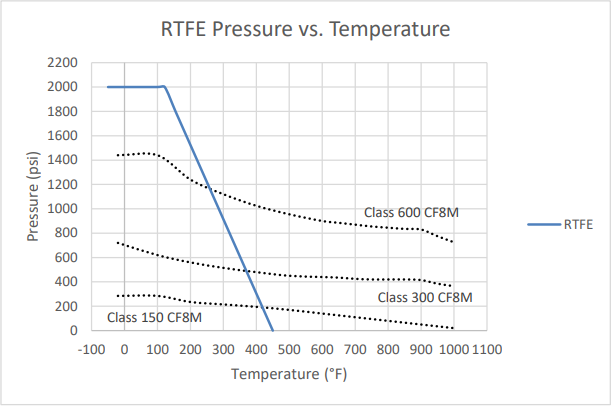
TFM Ball Valve Seats
Temperature Range: -75°F to 500°F
Max Pressure at Room Temperature: 2000 psi
Color: Transparent White
TFM (sometimes referred to by the brand name Dyneon) is a second-generation PTFE material that combines the best properties of PTFE (low friction, chemical resistance, high-temperature performance) with better stress recovery and the ability to handle higher pressures. It is also more elastic and resilient than PTFE. The operating temperature of TFM ranges from -100°F to 450°F and it is well adapted to applications involving steam and thermal fluids.
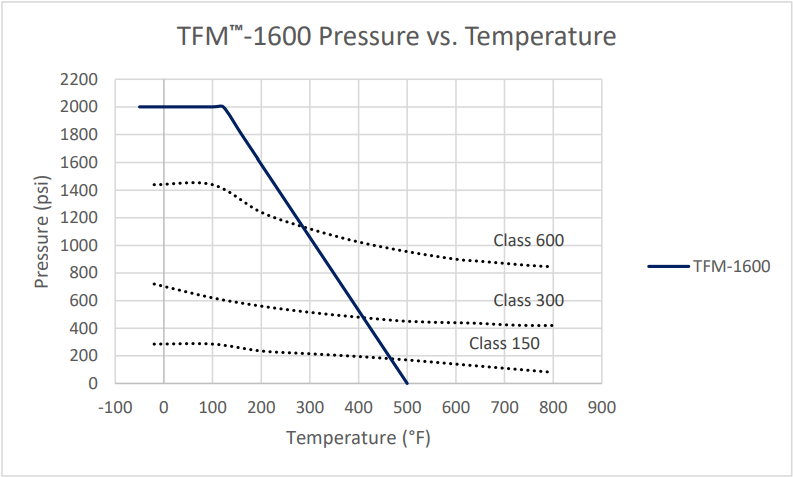
UHMW-PE Ball Valve Seals
Temperature Range: -40°F to 180°F
Max Pressure at Room Temperature: 2000 psi
Color: Transparent White
UHMW-PE, which stands for Ultra-High Molecular Weight Polyethylene, has a low coefficient of friction, an operating temperature ranging from -70° F to 200°F, good chemical resistance, good dimensional stability, and good abrasion resistance. In general ball valve seats made from UHMW-PE can handle pressures up to 1,500 psi and can handle low to medium levels of radiation exposure.
Delrin Ball Valve Seats
Temperature Range: -40°F to 180°F
Max Pressure at Room Temperature: 6000 psi
Color: White
When aggressive environments are involved, Acetal (also known as Delrin) is often used. Acetal provides excellent wear resistance, is very rigid, has good toughness, and is resistant to cold flow. Although its operating temperature range is not very wide (-70°F to 180°F), it can handle pressures up to 5,000 psi. Acetal also works well in radioactive environments but should not be used with oxygen flow.
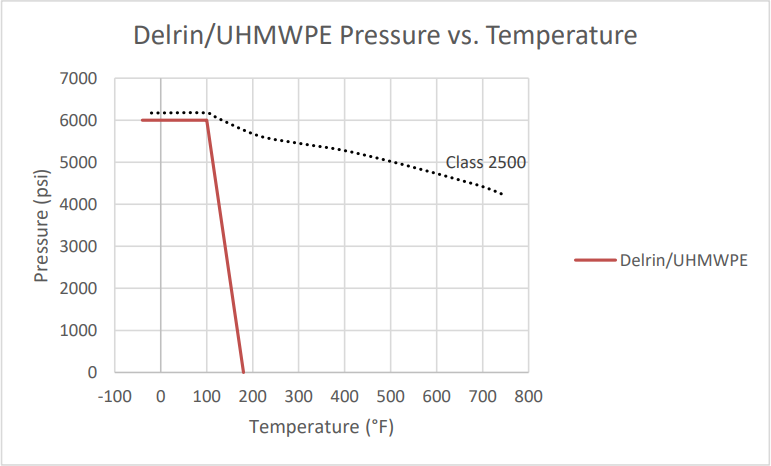
Butterfly Valve
We have different types of butterfly valves for various applications. The type of butterfly valve seal used depends on the application conditions: temperature, pressure, and type of media. For more information on what pressure and temperature a valve can tolerate, refer to the specs published by the manufacturer.
BUNA-N (B) Butterfly Valve Seats
BUNA-N is another name for nitrile which is a synthetic rubber copolymer of acrylonitrile (ACN) and butadiene. Because of its abrasion resistance, tensile strength, and low compression set, this rubber is a widely used elastomer in the seal industry.
BUNA-N is highly resistant to hydraulic fluids, water, alcohols, acids, petroleum-based oils, fuels, silicone greases, etc. However, what makes it strong also makes it inflexible. BUNA temperature rating is 0°F to 180°F and is heat resistant up to 225°F.
This material is used in some automotive applications. However, BUNA-N is not suitable for applications that involve acetones, ketones, chlorinated hydrocarbons, nitro hydrocarbons, or ozone.
EPDM (E) Butterfly Valve Seats
Rated for temperatures -30°F to 250°F. EPDM is an abbreviation of a compound called Ethylene Propylene Diene Monomer. It is also commonly called EPT, Nordel, and EPR. EPDM is used extensively in the HVAC industry due to its resistance to polar compounds such as water, phosphate, esters, ketones, alcohols, and glycols. The EPDM material is also applicable for handling concentrated sulfuric acid, 20% sodium hypochlorite (bleach), chlorinated water for swimming pools, and other alkaline solutions. EPDM is not resistant to hydrocarbon solvents and oils, chlorinated hydrocarbons, turpentine, or any other petroleum-based oils.
PTFE (P) Butterfly Valve Seats
PTFE is an abbreviation of the term polytetrafluoroethylene and is commonly known as Teflon. This thermoplastic fluoropolymer has low friction, chemical resistance, and fire-resistant qualities. Teflon is used to create some resilient seated butterfly valves.
PTFE is a cost-effective material in applications such as chemical processing or oil and gas. Because of its insulation quality, it is compatible with electrical applications. However, it should not be used in high-pressure conditions. PTFE temperature rating ranges from -50°F to 400°F.
VITON (V) Butterfly Valve Seats
VITON is a registered trademark name for a fluorocarbon elastomer made by Dupont. 3M’s version of this material is known as Flour. This elastomer offers heat and chemical resistance.
VITON is resistant to mineral acids and hydrocarbon products that are either concentrated or diluted. VITON temperature rating ranges from -20°F to 300°F.
Fluorocarbon is used in applications that involve petroleum oils, chlorinated hydrocarbons, salt solutions, and mineral acids. Because of its heat tolerance and resistance to corrosion, VITON is used in the manufacture of valve seats such as a knife gate valve. However, this valve is not compatible with processes that involve water or steam.
The following section outlines some of the fundamental aspects of the properties, capabilities, and application of these materials.
Material types
Table 1 shows the polymer types, used in valve applications, together with common abbreviations and Tradenames for the materials mentioned in these Guidelines.
Table 1 Soft seat thermoplastic materials
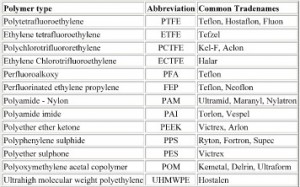
Polymer type Abbreviation Common Tradenames
Polytetrafluoroethylene ,PTFE Teflon, Hostaflon, Fluon
Ethylene tetrafluoroethylene, ETFE Tefzel
Polychlorotrifluororethylene, PCTFE Kel-F, Aclon
Ethylene Chlorotrifluoroethylene, ECTFE Halar
Perfluoroalkoxy, PFA Teflon
Perfluorinated ethylene propylene, FEP Teflon, Neoflon
Polyamide – Nylon PAM Ultramid, Maranyl, Nylatron
Polyamide imide, PAI Torlon, Vespel
Polyether ether ketone, PEEK Victrex, Arlon
Polyphenylene sulphide, PPS Ryton, Fortron, Supec
Polyether sulphone, PES, Victrex
Polyoxymethylene acetal copolymer, POM Kemetal, Delrin, Ultraform
Ultrahigh molecular weight polyethylene, UHMWPE, Hostalen
In general, these materials can be divided into several generic groupings: Fluoropolymers – Polymers such as PTFE, PCTFE, ECTFE, etc are based on fluorinated hydrocarbon chain polymers, derived mainly from tetrafluoroethylene and various chloro- derivatives.
Phenol-derived polymers – Linear polymers such as PEEK, PES, and PPS incorporate phenylene groups, together with oxygen, sulfur and carbon.
Polyamides – Polymers, such as the nylons and PAI, incorporate the -NH-(C=O)- group. Polyolefins – Hydrocarbon chain polymers, such as polyethylene and polypropylene.
Mechanical properties
The thermoplastic materials differ fundamentally from elastomers in that they have many reduced elastic capabilities, and undergo permanent deformation when subjected to strains of more than 5 to 10% or so (c.f. the elongation of rubbers, which may be between 70 & 700%).
The mechanical properties of these materials vary considerably, and their successful application depends on appropriate materials selection. In essence, the level of mechanical properties of a material governs the pressure at which that material can be successfully employed. As strength properties invariably fall off with temperature, the pressure rating of a soft seat material in a valve application will also be reduced as the temperature increases.
To extend the pressure capabilities of thermoplastics at elevated temperatures, they are often blended with reinforcing fillers such as glass or carbon fiber, to improve strength and stiffness. Other fillers, such as graphite, MoS2, or PTFE, may be added to reduce friction, and control valve torque.
Table 2 shows the typical mechanical properties of virgin and filled thermoplastic polymers, used as valve soft seats.
Table 2 Mechanical properties of thermoplastic valve seat materials
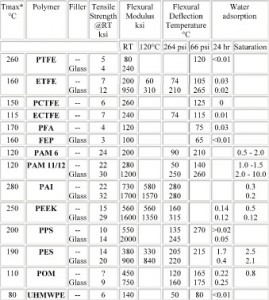
Chemical resistance
Thermoplastic materials generally show excellent chemical resistance. There is, however, a balance between the degree of chemical inertness and mechanical properties – one can be improved at the expense of the other, e.g. PTFE is the most chemically inert of all, but has rather inferior mechanical properties.
There are several other points to note. Whilst the fluorocarbon materials have very low water absorption, several of the other materials, in particular the nylons, absorb rather large amounts of moisture. There are also certain chemical types that attack certain materials: acids affect PEEK and POM; aromatics affect ECTFE; ethers and esters affect ECTFE and PCTFE; alkalis affect PAI and POM.
Table 3 is a summary of the outstanding features of each of the thermoplastic materials used as soft seats.
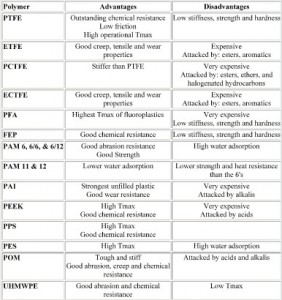
Polymer Advantages Disadvantages
PTFE Outstanding chemical resistance Low friction High operational Tmax Low stiffness, strength, and hardness
ETFE Good creep, tensile, and wear properties Expensive Attacked by: esters, aromatics
PCTFE Stiffer than PTFE Very expensive Attacked by: esters, ethers, and halogenated hydrocarbons
ECTFE Good creep, tensile and wear properties Expensive Attacked by: esters, aromatics
PFA Highest Tmax of fluoroplastics Very expensive Low stiffness, strength, and hardness
FEP Good chemical resistance Low stiffness, strength, and hardness
PAM 6, 6/6, & 6/12 Good abrasion resistance Good Strength High water adsorption
PAM 11 & 12 Lower water adsorption Lower strength and heat resistance than the 6’s PAI Strongest unfilled plastic Good wear resistance Very expensive Attacked by alkalis
PEEK High Tmax Good chemical resistance Very expensive Attacked by acids
PPS High Tmax Good chemical resistance
PES High Tmax High water adsorption
POM Tough and stiff Good abrasion, creep and chemical resistance Attacked by acids and alkalis
UHMWPE Good abrasion and chemical resistance Low Tma
Related Tags :
Ten articles before and after
IP code – Ingress Protection Ratings(valve actuator)
Wafer type Double Disc/Piston lift Check Valve-Installation, Operation and Maintenance Manual
Valve Price Doesn’t Mean Everything
Aker Solutions wins Heidrun platform equipment frame agreement
China and main country Valve Welding material(electrode) for sealing surface
Globe Valve Installation,Operation and Maintenance Manual
Ball Valves Installation, Operation And Maintenance Manual
Application of advanced technology in the domestic large pipeline valve:all welded ball valve










